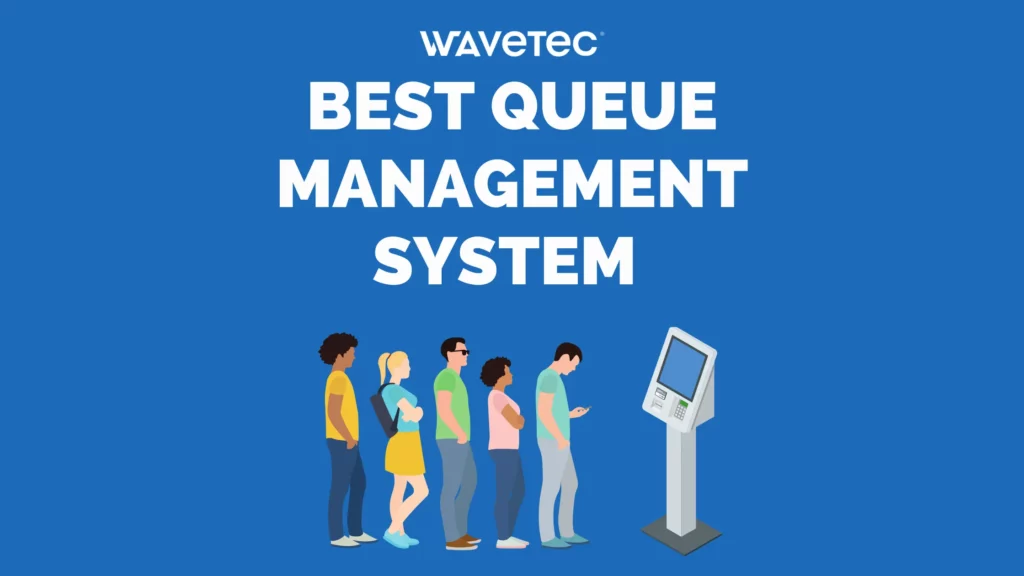Have you witnessed overcrowding and mismanaged queues at the reception and wait area?
An efficient electronic queue management system is the solution to the chaos businesses encounter in stores. With a queue management system, customers receive virtual tickets and reserve spots in lines. In turn, customers are issued unique ticket numbers to check wait times.
In order to enhance the customer experience, businesses often utilize digital signage to display tickets in waiting or queuing areas. This centralized system not only saves customers’ time but also provides an opportunity for the business to manage the content displayed and monitor key performance indicators.
One of the most significant benefits of this system is that it reinforces the brand identity of the business. By displaying information in a clear and transparent manner, customers are more likely to feel valued and return for future transactions.
In this blog, you will learn how the queue management system works with digital signage in an everyday setting.
Let’s get started!
How the Queue Management System Works with Digital Signage
Customer check-in
The customer’s journey begins with arriving at the location and initiating the check-in process by issuing a ticket from a physical ticket dispenser or using the self-service kiosk.
Wavetec offers a virtual queuing solution that allows customers to check in via a website, mobile app, or WhatsApp Queuing Solutions. Customers input personal information, including contact details or service requests, using either of the services. The information is recorded, and a unique ticket number is assigned to each customer.
Queue management
Once check-in is completed, the queue management software takes over the process of customer flow management. An ideal queue management software is a multi-channel integration that improves a customer’s journey from the start to the end.
It issues online and offline ticketing and collects customer feedback and data to analyze and predict wait times.
Displaying of queue information on digital signage
Wavetec’s digital signage solution displays are LED-based, offering a real-time dashboard to display text, multimedia or pictures. The QMS sends summarized customer data to be displayed on screens.
Customers can get queuing information in a clear and organized manner. This can show ticket numbers or customer names sequentially to indicate the current and upcoming customers in the queue.
Use the digital signage in waiting areas for promotions, announcements, and service instructions to keep consumer engagement high. Digital signage screens in service areas allow customers to view wait times and stay updated on their queue status, which reduces wait time anxiety for customers.
Customers receive notifications when it’s their turn
The QMS sends customers push notifications, text messages or emails to update them with the queue status. This allows your customers to use their time efficiently and prevents overcrowding.
Feedback collection
Towards the end of the consumer journey, use the self-service kiosks or online surveys such as Opinion Plus to get customer feedback. Knowing the pain points of a consumer journey is key to improving your services and extending a personalized experience.
Analytics and Reporting
Spectra Queue Management Software is a complete package and a central ecosystem that displays analyzed data on digital signage screens.
4 Features of a Queue Management System with Digital Signage
When you sign up for a queue management system with digital signage, you should look for key features that set it apart.
Let’s find out what they are:
Real-time queue information
Queue Management System with Digital Signage provides real-time queue information, including the number of customers ahead of you, wait times, and service times. Customers get virtual queue numbers and automated notifications via SMS, email, or other channels to inform them of their turn.
Since digital signage solutions are integrated with QMS, queuing information is updated dynamically as it progresses. Any changes in queue status or wait times are reflected immediately as alerts. Investing in a proactive management system will minimize customer inconvenience and build trust.
Customizable display screens
When installing a QMS, ensure that digital signage screens are customizable with a real-time display giving information for multiple queues separately. Donatello Media Player allows you to display engaging promotional content and visually appealing messaging that will prompt customers to try out more services.
An ideal digital signage board should have remote content management capabilities with scheduling options. Donatello Vertica is particularly useful in displaying content in multiple languages, catering to a broader audience. LED displays are a step higher in terms of resolution, scalability and content branding.
Integration with other systems
To streamline operations, businesses can integrate QMS, digital signage and point-of-sale systems that automatically update queue status based on customer checkout.
Similarly, you can sync Customer Relationship Management and Appointment Scheduling with customer information and appointment data with QMS.
Lastly, with mobile application integration, QMS can help customers stay updated.
Analytics and Reporting
QMS, with digital signage solutions, processes data as key performance indicators (KPIs) like wait times, service times, queue lengths, and customer flow. This allows businesses to monitor queue performance, understand consumer habits and optimize operations accordingly.
Most are equipped with data visualisation features for exporting and reporting on dashboards and graphs. Moreover, a QMS can perform comparative analysis against parameters such as time market competition.
5 Upgrading to digital waiting room signage
If you are planning to switch to a versatile virtual queue management system, do not worry. We have listed the steps to help you make the switch easily!
Find a suitable provider for virtual queue management
The first step of finding a suitable vendor for QMS is conducting a thorough market survey. The goal should be to look for vendors who offer products of your interest. Look for a provider with positive customer reviews with excellent customer support.
Assess the overall functioning costs with recurring charges and potential return on investments. Ensure that the provider follows HIPAA guidelines to protect customer data and confidentiality.
Select the devices of your preference
A virtual QMS comes with an array of devices and technology to choose from. You must select the placement of widgets according to the layout of your waiting room.
You can invest in digital signage displays, media players, and interactive self-service kiosks to keep the consumer engaged. Consider factors such as the durability of the product, reliability and budgeting.
Personalize your virtual waiting list
Brand the virtual waiting list to give your business a professional outlook. Use branding elements like your business’s logo and fonts throughout the virtual queuing page. Add customized messages relevant to the virtual wait room.
These can be welcome messages, instructions for check-in and appointment and wait time updates. It is necessary that you choose multiple language options and a simple user interface.
Conduct a trial run of your waitlisting system
Before launching the trial run, define the objectives you want to test out, such as reducing wait times. Choose a group of participants using the virtual QMS in a real-world scenario.
When the participants test out the system in a timeframe, determine the functionality, performance and accuracy of prediction. Ensure you gather consumer feedback on ease of use and make follow-up testing if necessary.
Launch your waitlisting system
Now that you know the hardware and the QMS software, you will install and configure the waitlisting system. These include setting limits on the number of customers, average wait times and cancellations.
Your staff should be trained to use and guide the customers regarding the virtual QMS. You should be monitoring key metrics to determine areas of improvement.
Applications of a Queue Management System with Digital Signage
Although Digital Signage with QMS has revolutionised multiple industries, airport services have benefited the most. dnata Travel, a leading travel management company, installed Wavetec’s solutions. This enabled them to display real-time flight information and travel offers. With the QMS, customers were able to navigate ticket counters easily and reduced waiting time.
Azerconnect of the telecommunications industry installed Digital Signage solutions. This helped them improve foot traffic and display real-time information and announcements leading to revenue generation.
We have another example from the banking industry for you. The BCI Bank Academy used Donatello Digital Signage solutions to make data-driven decisions and redefine customer service queues.
Wavetec Solutions gave BCI a centralized crowd and content control with the queue management system. The bank was able to use digital signage technology to promote offers, news and financial literacy content.
Conclusion
If you want to see your staff productivity levels boost and improve consumer satisfaction, it is time to make an investment.
Learn how a queue management system works with digital signage with real-time information, customized branding, and data-driven insights. Businesses can optimize their queue management processes and create a seamless and engaging customer waiting experience.
From reducing perceived wait times to driving customer engagement, a QMS with digital signage is a smart solution.
Contact us, and we will help you improve queue management strategies and deliver exceptional customer service today!
BOOK A FREE DEMO





